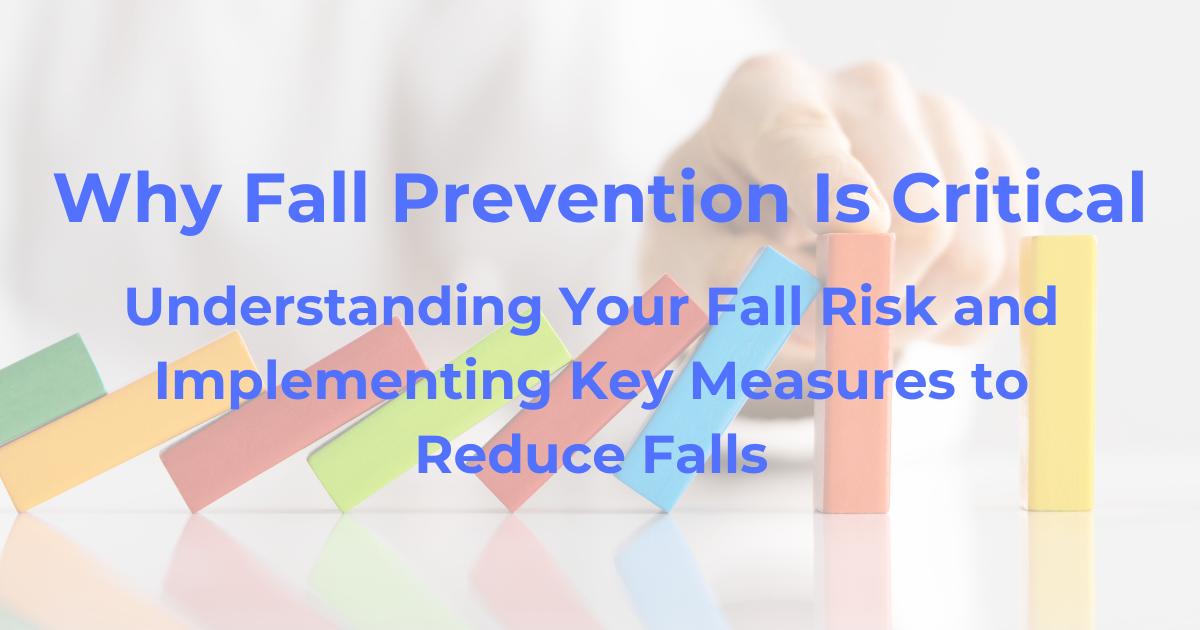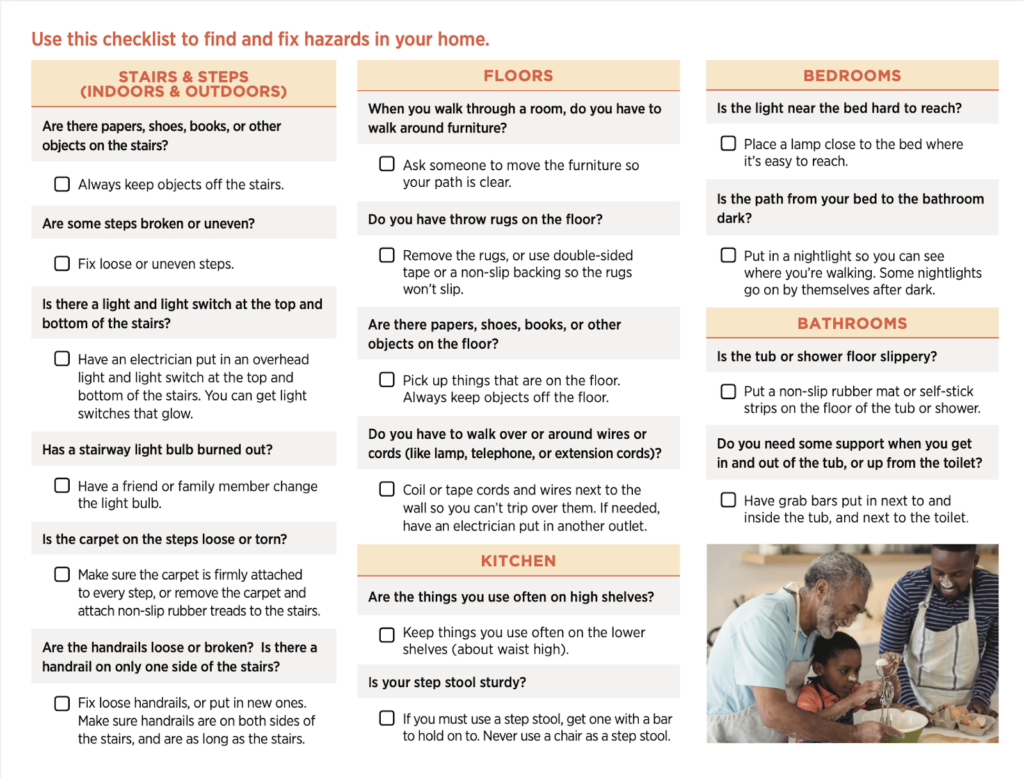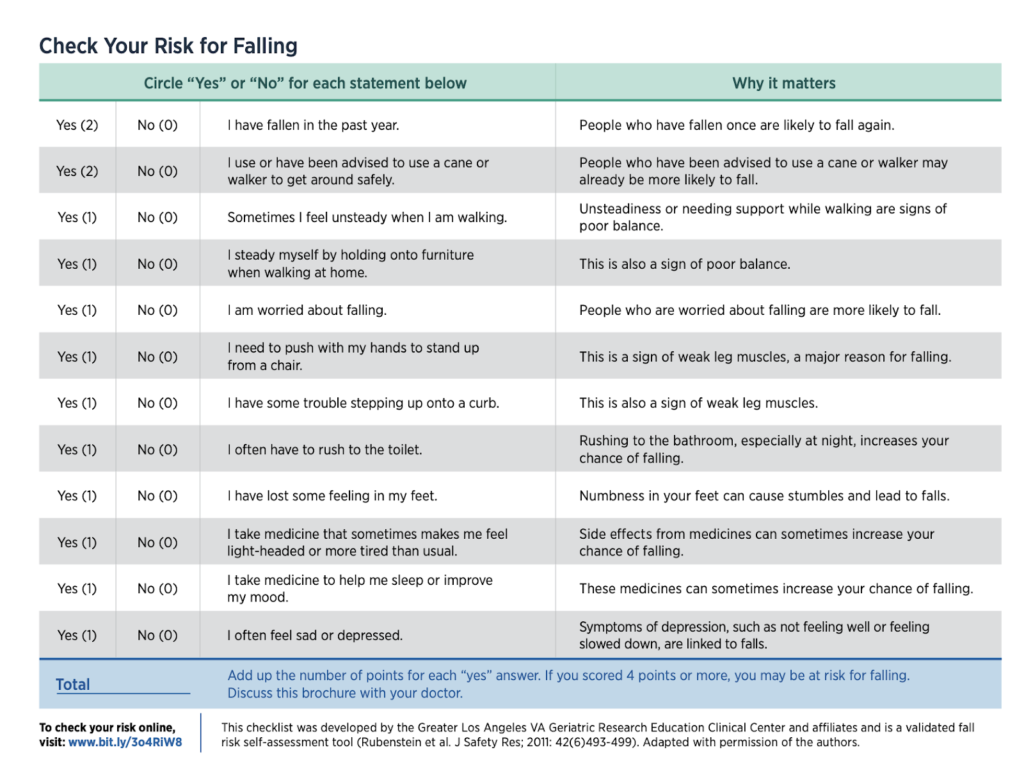Preventing falls is a critical concern for older adults, as they can lead to serious injuries and a decline in independence.
Falls
Recognizing fall risks is a crucial step in safeguarding elderly adults from potential injuries. Factors such as age-related changes in muscle strength, joint flexibility, and bone density can increase the likelihood of falls. Medical conditions like arthritis, heart disease, or problems with vision and hearing exacerbate the risk.
Let’s get concrete! Let’s look at the processes we use everyday and identify how we are mitigating these risk factors.
When it comes to the home environment, it can either be a safe haven or a landscape filled with hazards. To ensure the former:
Check out this link for more information on risk factors for fall.
Medications play a significant role in an individual’s balance and stability. Some may cause dizziness or drowsiness, affecting coordination. It’s imperative to:
By addressing these risk factors through proactive measures – from home modifications to medication management – you create a safer environment that significantly reduces the probability of falls.
Using the CDC-Created STEADI Checklist Check Your Risk For Falling:
In a study of over 25,000 people over the age of 65, the WHO found that improving strength and balance through exercise reduces by up to 42% with a weekly dose of 3 or more hours.
“For older adults, the most effective single intervention is strength and balance exercises” – Dr. Elizabeth Phale, Founding Director of the Fall Prevention Clinic
Regular physical activity is crucial for preventing falls in older adults. It works by improving four three physical qualities:
Strength and balance training is essential for preventing falls. Doing these exercises, you will experience several advantages:
Pro Tips:
Perform training in a safe place, where you can catch yourself if you lose your balance, since that may happen when you are working to improve your balance
·To improve balance find a challenging position (i.e. feet together, or one foot in front of the other
Key takeaway: Strength and balance training goes beyond just gaining muscle; it helps to boost your stability while moving around providing increased confidence. This newfound confidence can actually decrease the fear of falling, which is known to be a separate risk factor for falls. It also supports developing a body that can handle the aging process more effectively, making it an essential part of a fall prevention strategy.
In conclusion, the benefits of strength and balance training for preventing falls are multifold and impactful. By engaging in exercises designed to enhance muscle strength and balance, individuals can significantly reduce their risk of falls and the associated injuries. From increased stability while standing or walking to a heightened capacity to perform daily activities with balance, the advantages are numerous. Moreover, the strengthening of bones and muscles through such training not only fortifies the body against potential injuries but also instills a newfound confidence in movement, thereby mitigating the fear of falling—a significant risk factor in itself.
When considering incorporating strength and balance training into your routine, it’s essential to seek guidance from trusted professionals. At Group Otago, we specialize in providing fun group exercise programs aimed at enhancing overall strength and balance to reduce the risk of falls. Our experienced team offers personalized programs and expertise to help you maintain independence as you age.
By seeking out a Group Otago exercise class near you, you will gain access to comprehensive strength and balance training resources and expert guidance to embark on your journey toward overall health in a fun environment. Together, let’s prioritize proactive measures to safeguard against falls and enjoy a fulfilling and active lifestyle.
For more information about Group Otago and how we can assist you in your fall prevention efforts, visit our website at https://groupotago.com/.

Preventing falls is a critical concern for older adults, as they can lead to serious injuries and a decline in independence.

Recognizing fall risks is a crucial step in safeguarding elderly adults from potential injuries. Factors such as age-related changes in muscle strength, joint flexibility, and bone density can increase the likelihood of falls. Medical conditions like arthritis, heart disease, or problems with vision and hearing exacerbate the risk.
Let’s get concrete! Let’s look at the processes we use everyday and identify how we are mitigating these risk factors.When it comes to the home environment, it can either be a safe haven or a landscape filled with hazards. To ensure the former:
Check out this link for more information on risk factors for fall.


Using the CDC-Created STEADI Checklist Check Your Risk For Falling
Medications play a significant role in an individual’s balance and stability. Some may cause dizziness or drowsiness, affecting coordination. It’s imperative to:
By addressing these risk factors through proactive measures – from home modifications to medication management – you create a safer environment that significantly reduces the probability of falls.
In a study of over 25,000 people over the age of 65, the WHO found that improving strength and balance through exercise reduces by up to 42% with a weekly dose of 3 or more hours.
For older adults, the most effective single intervention is strength and balance exercises.
Dr. Elizabeth Phale, Founding Director of the Fall Prevention Clinic Tweet
Regular physical activity is crucial for preventing falls in older adults. It works by improving four three physical qualities:
Strength and balance training is essential for preventing falls. Doing these exercises, you will experience several advantages:
Perform training in a safe place, where you can catch yourself if you lose your balance, since that may happen when you are working to improve your balance· To improve balance find a challenging position (i.e. feet together, or one foot in front of the other
Key takeaway: Strength and balance training goes beyond just gaining muscle; it helps to boost your stability while moving around providing increased confidence. This newfound confidence can actually decrease the fear of falling, which is known to be a separate risk factor for falls. It also supports developing a body that can handle the aging process more effectively, making it an essential part of a fall prevention strategy.
In conclusion, the benefits of strength and balance training for preventing falls are multifold and impactful. By engaging in exercises designed to enhance muscle strength and balance, individuals can significantly reduce their risk of falls and the associated injuries. From increased stability while standing or walking to a heightened capacity to perform daily activities with balance, the advantages are numerous. Moreover, the strengthening of bones and muscles through such training not only fortifies the body against potential injuries but also instills a newfound confidence in movement, thereby mitigating the fear of falling—a significant risk factor in itself.
When considering incorporating strength and balance training into your routine, it’s essential to seek guidance from trusted professionals. At Group Otago, we specialize in providing fun group exercise programs aimed at enhancing overall strength and balance to reduce the risk of falls. Our experienced team offers personalized programs and expertise to help you maintain independence as you age.
By seeking out a Group Otago exercise class near you, you will gain access to comprehensive strength and balance training resources and expert guidance to embark on your journey toward overall health in a fun environment. Together, let’s prioritize proactive measures to safeguard against falls and enjoy a fulfilling and active lifestyle.
For more information about Group Otago and how we can assist you in your fall prevention efforts, visit our website at https://groupotago.com/.